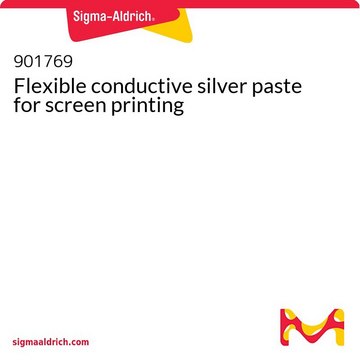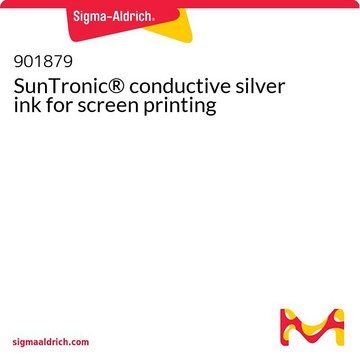Key Documents
791512
Platinum paste, screen printable
Synonim(y):
Greatcell Solar PT1 platinum paste, Pt paste, conductive paste
About This Item
Polecane produkty
Postać
paste (Amber)
lepkość
2500-4500 mPa.s (Analysis carried out at 20°C with 20mm 4 degree cone/plate; 40 s-1)
temp. przechowywania
2-8°C
InChI
1S/Pt
Klucz InChI
BASFCYQUMIYNBI-UHFFFAOYSA-N
Powiązane kategorie
Zastosowanie
PT1 Platinum Paste is oil-based and formulated to be applied using a screen printer; providing films with excellent uniformity; performance and reproducibility; and can be used for DSSC polot production.
After drying; this paste must be fired at or above 420°C. This results in uniformly distributed platinum nanoclusters; providing good transparency and high catalytic activity for the electrochemical reduction of I3- to I-.
Suggested Mesh Screen: 100T
Informacje prawne
Greatcell Solar is a registered trademark of Greatcell Solar Materials Pty Ltd
Hasło ostrzegawcze
Danger
Zwroty wskazujące rodzaj zagrożenia
Zwroty wskazujące środki ostrożności
Klasyfikacja zagrożeń
Eye Dam. 1 - Resp. Sens. 1 - Skin Irrit. 2 - Skin Sens. 1
Kod klasy składowania
10 - Combustible liquids
Klasa zagrożenia wodnego (WGK)
WGK 1
Temperatura zapłonu (°F)
194.0 °F
Temperatura zapłonu (°C)
90 °C
Wybierz jedną z najnowszych wersji:
Masz już ten produkt?
Dokumenty związane z niedawno zakupionymi produktami zostały zamieszczone w Bibliotece dokumentów.
Klienci oglądali również te produkty
Produkty
Dye-sensitized solar cells (DSCs) are 3rd generation solar cells combining the promise of high efficiency with low production costs.
While dye sensitization as the basis for color photography has been accepted for a very long time,1 attempts to use this principle for the conversion of solar light to electricity generally had resulted only in very low photocurrents, below 100 nA/cm2.2
Professor Tokito and Professor Takeda share their new materials, device architecture design principles, and performance optimization protocols for printed and solution-processed, low-cost, highly flexible, organic electronic devices.
Recent progress in the area of solution-processed functional materials has led to the development of a variety of thin-film optoelectronic devices with significant promise in the industrial and consumer electronics fields.
Nasz zespół naukowców ma doświadczenie we wszystkich obszarach badań, w tym w naukach przyrodniczych, materiałoznawstwie, syntezie chemicznej, chromatografii, analityce i wielu innych dziedzinach.
Skontaktuj się z zespołem ds. pomocy technicznej












